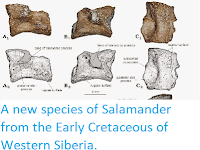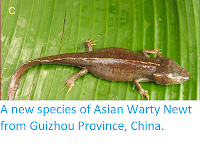The Chinese Giant Salamander, Andrias davidianus, is the largest extant species of Amphibian, reaching about 1.8 m in length. It is one of only three species of Giant Salamander, Cryptobranchidae, along with the Japanese Giant Salamander, Andrias japonicus, and the Hellbender, Cryptobranchus alleganiensis, which is found in the eastern United States, which are thought to have diverged from their closest relatives during the Middle Jurassic, around 170 million years ago. The species was once widespread across China, but it's wild population is thought to have declined by about 80% since the 1950s, due to a combination of habitat loss, disease, and consumption by Humans. For this reason the species is considered to be Critically Endangered under the terms of the
International Union for the Conservation of Nature’s Red List of Threatened Species. As such the species has become a focus for conservation efforts in China, which have focused on the release of large numbers of farmed Giant Salamanders back into the wild, with over 78 000 farmed Salamanders released into the wild since 2008.
In a paper published in the journal Current Biology on 21 May 2018, a group of scientists led by Fang Yan of the State Key Laboratory of Genetic Resources and Evolution at the Kunming Institute of Zoology of the Chinese Academy of Sciences present evidence that the Chinese Giant Salamander should in fact be considered to be a species cluster (group of morphologically identical but genetically distinct species, known as 'cryptic species') rather than a distinct species, and discuss the implication of this for conservation efforts.
A Chinese Giant Salamander, Andrias davidianus, in the Shanghai Aquarium. Patrick Fischer/Wikimedia Commons.
Yan et al. collected genetic samples from 70 wild caught and 1034 farmed Salamanders from across the species' range. They found that the wild Salamanders could be grouped into five distinct genetic populations, which appear to have diverged from one-another between 4.71 and 10.25 million years ago, sufficient to be considered to be separate species under most classification systems (Humans and Chimpanzees are thought to have diverged between 4 and 13 million years ago). This is not greatly surprising, as the Salamander favour upland environments, and therefore have a scattered distribution, with wide areas in between that the Salamanders cannot easily cross.
The farmed Salamanders, in contrast, appeared to be largely hybrids, with the majority of their DNA derived from a population in the Yellow River in Shaanxi Province, the area where they were first farmed. The ability of the separate species to hybridise is not considered surprising, as the Chinese Giant Salamander is known to be able to hybridise with the (more distantly related) Japanese Giant Salamander. However the resultant hybrid Salamanders show much lower genetic diversity than wild Salamanders, and may be less well adapted to surviving in the wild.
mtDNA haplotype clades and genetic structure of wild-caught and farm-bred Chinese Giant Salamanders. (A) A simplified Bayesian inference tree based on concatenated mtDNA haplotypes. Numbers near branches are posterior probabilities (BPP ≥ 0.90). A–E are wild caught populations and U1 and U2 are known from farms only. (B) Sampling sites for wild-caught individuals. Lower-right insert shows the best genetic clustering (K = 5) based on genomic SNPs from localities circled in dashed line. (C) Sampling sites for farm-bred individuals where pie charts show the proportions of mitochondrial haplotypes as grouped in (A). Lower-right insert shows the second-best cluster (K = 3; optimal K = 1) based on microsatellite data for farm-bred individuals from Guizhou (farms circled in dashed line). Colours denote cryptic species lineages. Yan et al. (2018).
Yan et al. express concern that the practise of releasing farmed Salamanders (from populations originally intended form commercial exploitation as a food animal) into the wild may have a strongly adverse effect on the wild populations, potentially leading to some species becoming extinct; indeed they could find no pure indigenous Salamanders in some tributaries of the Pearl and Yangtze rivers, where all captured individuals had mtDNA (mitochondrial DNA, which is passed on only through the female line) from Yellow River Salamanders. They recommend that in future conservationists should avoid the release of captive-raised animals until a full study of the genetic structure of the subject population is carried out.
See also...
Follow Sciency Thoughts on Facebook.








